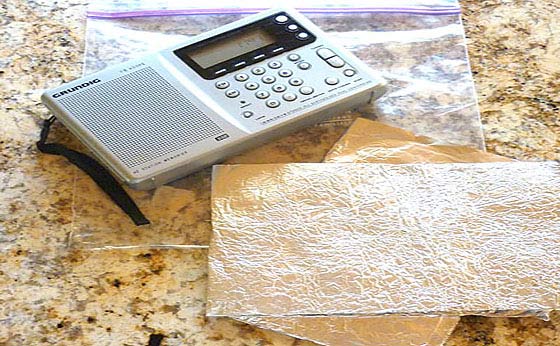How To Protect A Portable Radio From EMP

Protecting a portable Shortwave/AM/FM radio from an EMP (electro-magnetic-pulse) is (theoretically) fairly easy, and is a wise course of preventative action to take with a critical electronic piece of equipment like a radio which could provide you with critical news and information about an ongoing disaster…
An EMP event (from a solar super-storm or nuclear EMP attack) could bring down the electrical power grid — either regionally or even wider; and if strong enough, it has the potential to critically damage circuits within electronic devices…
A portable shortwave radio has the ability to receive stations all around the world, and could be your information lifeline after an EMP event — enabling you to hear communications from far away in other regions of the world that are still “up and running”, and will provide invaluable insight to your predicament.
The thing is… if your radio has been fried by the EMP, then you’re SOL…
An EMP
An EMP from a nuclear atmospheric detonation is an instantaneous jolt of tens of thousands of volts per square meter that is generated from the interaction between the explosion and the Earth’s magnetic field.
The invisible but catastrophic pulse occurs instantly over an area that is within line-of-sight of the EMP-weapon detonation while its devastating electro-magnetic-pulse decays by the inverse-square-law the further away it gets form its origin.
Having said that, an EMP detonation at an altitude of 50 miles would affect an area with a diameter of 1,400 miles while a detonation altitude of 200 miles would affect an area of 2,900 miles in diameter. The area directly beneath the blast is affected the worst, while the extreme fringes are barely affected.
The EMP effects from from a massive solar flare event from the sun — similar to what happened in 1859 (the Carrington event), could also bring down the electrical power grid, although may not affect stand-alone electronics like radios, etc. as would a nuclear EMP weapon attack (the grid-down would be bad enough…).
An EMP potentially has the energy to wipe out things ‘electronic’ and could potentially send a region back to the 1800’s in the blink of an eye. An EMP weapon is a very real threat in today’s increasingly unstable world and has always been a threat from the sun.
Protect your portable radio from EMP
I will preface this opinion with the fact that none of us have ever experienced a major EMP event and there has never been an attack anywhere in the world using a nuclear EMP weapon (as of this post). Therefore any advice as to how and protect your electronics are theoretical at best. You might say that there has not been any real ‘hands-on’ experience…
First, completely wrap your portable radio in a non-conductive material being sure that no (metal) part of the radio is exposed before the next step. You can use paper, a paper bag, cardboard, or even easier…slip the radio inside a zip lock bag (if it fits). If using a Zip lock bag, ‘burp’ the bag of air for a nice snug fit.
Next firmly wrap the now-covered radio with aluminum foil — being sure not to leave any open spaces. Wrap tight and well.
Repeat the process for even more protection… another non-conductive layer or zip lock bag over the now-wrapped radio… followed by another wrapping of aluminum foil.
Lastly, place the now-wrapped radio in yet another bag so as to protect the outer foil layer from tearing.
The theory is that the pulse will enter the conductive foil and dissipate around it while not affecting (or inducing currents) within the electronic circuits which are isolated and protected inside the bag.
It is, in effect, a do-it-yourself Faraday cage. A Faraday cage is a conductive casing that prevents the electromagnetic radiation from reaching the electronic circuits contained within.
It is the opinion of many that a make-shift Faraday cage does not have to be grounded in order to prevent damaging electrical currents from an EMP getting inside the protected electronic circuits which are isolated within.
Another simple technique is to use a metal trash can with a secure metal lid. Line the trash can with cardboard or other such non-conductive material, and place your radio and other salvageable electronics inside.
